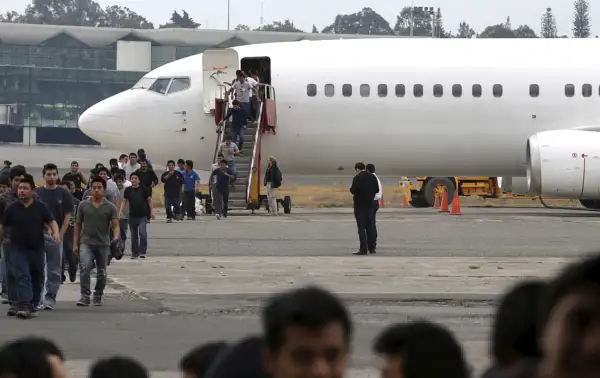The U.S. Runs Its Own Airline For Deportations. Here's How Much It Costs Taxpayers

President Trump's plans to deport 2 million to 3 million undocumented immigrants won't come cheap.
The Department of Homeland Security puts deportation costs at $8,661 per immigrant. The Center for American Progress, a left-leaning think tank, estimates that this figure would grow by almost $1,500 when the government increases efforts to capture more people inside the U.S.
That means taxpayers may have to pony up $22 billion to $25 billion. And about one-tenth of that goes to transportation costs, according to the Center for American Progress.
To transport undocumented workers to Central America and other far off locals in Europe, Asia and Africa, the U.S. Immigration and Customs Enforcement (ICE) charters its own flights, although sometimes ICE buys commercial seats. Those deported to Mexico are flown domestically to U.S. cities near the southern border, such as San Diego and Brownsville, Tex.. From there, they get a bus ride over the border.
As Quartz lays out, ICE Air Operations — or ICE Air — spent $8,419 per flight-hour on charters flying almost 1 million people from detentions centers to nations across the globe from October 2010 to March 2014.
Over that time, ICE Air spent nearly $600 million, which is greater than what was spent on the National Endowment for the Arts over the same period.
ICE Air apparently could learn a thing or two from commercial airlines.
An audit conducted in 2015 by the Office of Inspector General concluded that "although ICE Air met its mission by transporting 930,435 detainees over a 3-1/2-year period, it could have used its resources more effectively.
For instance, in recent years, commercial airlines have used technology to ensure that each flight is filled at or near capacity, which keeps fuel and labor costs down.
Flying at capacity is not something ICE Air does nearly enough, according to the Inspector General's report.
"ICE Air operated charter flights with empty seats and could have realized cost savings of up to $41.1 million upon determining optimum flight capacity," the report stated. "This estimate is based on the average of charter costs incurred during the scope period for the missions analyzed."
On domestic flights alone, ICE Air could have saved nearly $28 million simply by flying at fuller capacity, the audit report found.
The question is, does President Trump plan to use his private-sector skills to make ICE Air more cost effective? Or is it a bigger priority to quickly fulfill his goal of removing 2 million to 3 million undocumented workers with violent criminal records?
